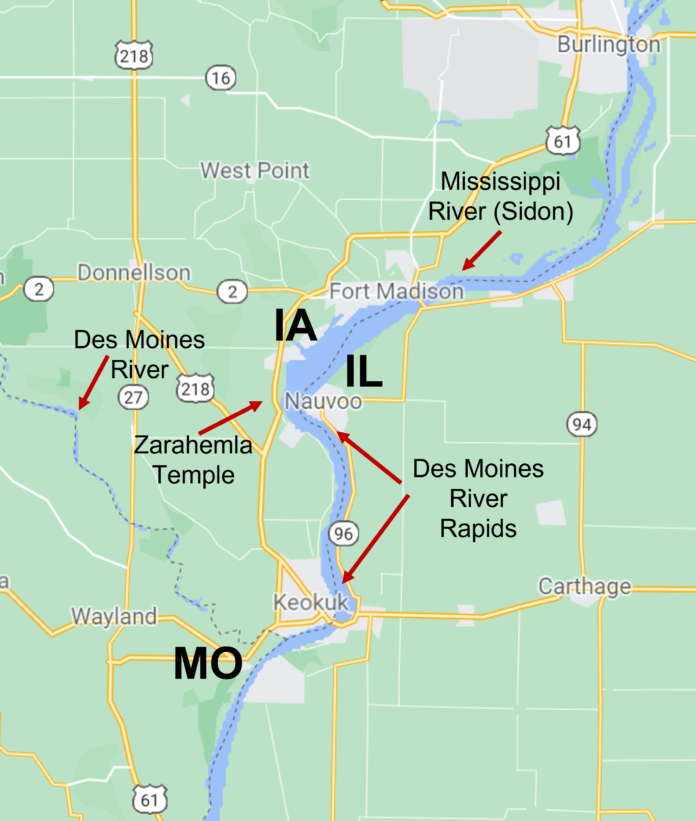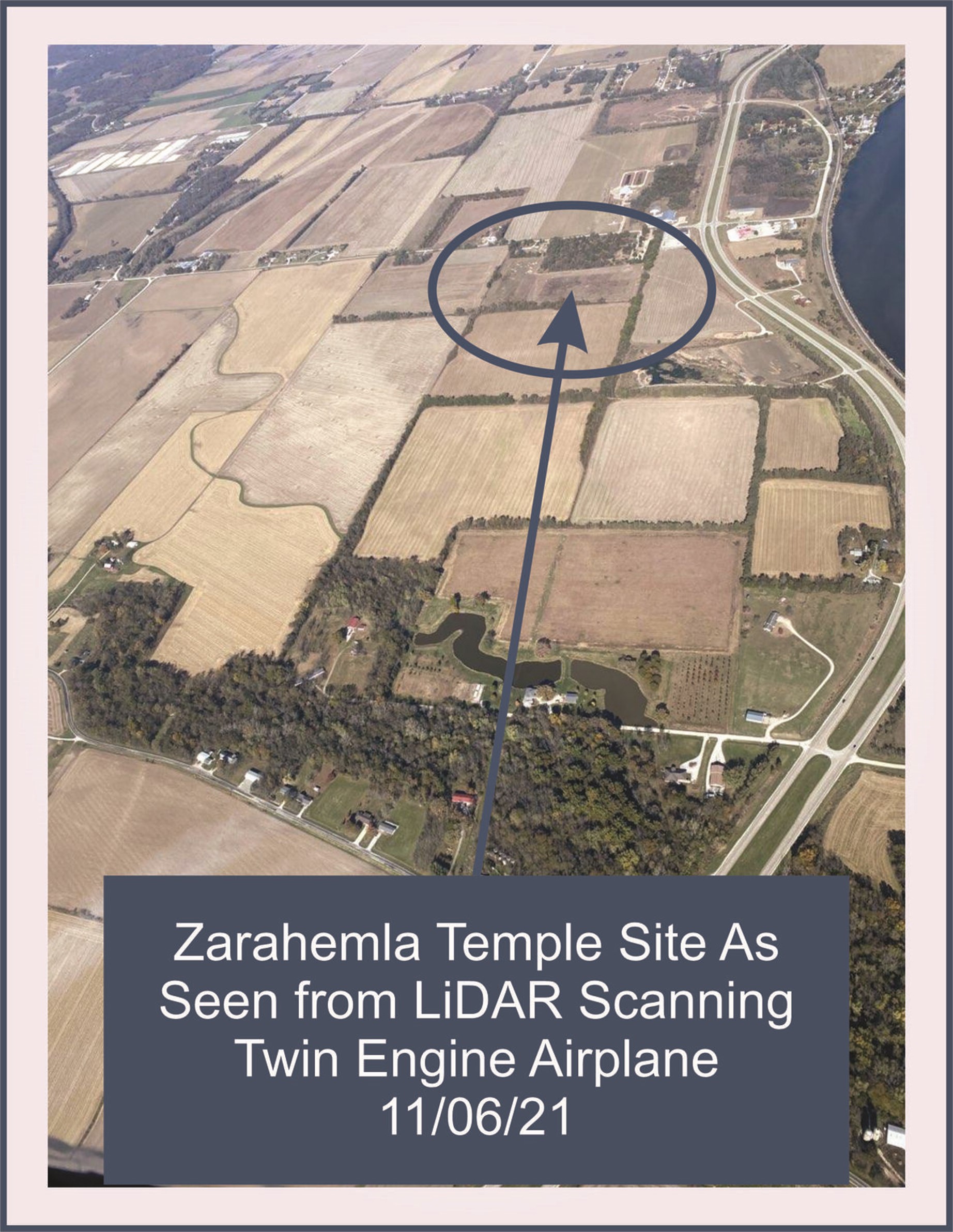“At the final dedicatory service for the Nauvoo Illinois Temple on June 30, 2002, President Gordon B. Hinckley (1910–2008) asked those in attendance to walk down Parley Street to the waterfront on the Mississippi River. Though it was a hot, humid day, President Hinckley asked everyone to imagine that it was a bitter cold day in February 1846. That summer evening, more than one thousand Latter-day Saints walked down Parley Street, now referred to as the Trail of Hope.” The Trail of Hope: Exodus from Nauvoo
Trail of Hope LOCATION: PARLEY STREET
Beginning just west of the Webb Blacksmith Shop, walk along a path next to Parley Street and read journal entries from pioneers who left Nauvoo under trying circumstances but with faith in their future. The end of the trail at the edge of the Mississippi River marks the beginning of the National Park Service designated Mormon Pioneer National Historic Trail.
I begin this blog with the end in mind. Not the end of the story, but the end of the original Saints living in Nauvoo, Illinois and Montrose, Iowa in 1846. We know the story continues even today.
There is something special when we speak about, visit, or reminisce about Nauvoo, the City Beautiful. Let us start by discussing some about the first time the Saints obtained the land we call Zarahemla with parts of an article by Stanley b. Kimball.
We will then briefly speak about The Trail of Hope in Nauvoo on a course towards the Rocky Mountains. This could very well be the Saints Trail, which the Native Americans and their Trail of Tears they walked earlier in 1830 to Oklahoma.
Then we will be directed to a new publication called the “Annotated Book of Mormon by David Hocking and Rod Meldrum. They will speak to the amazing importance of the City Zarahemla as spoken of in D&C 125. We strongly believe this ancient city was indeed in the United States of America near Nauvoo, Illinois.
Finally we will spend a brief moment reflecting on what the Latter-Day Saints and specifically, the Heartland Research Group are doing, to continue the research on this sacred area today.
I will specifically speak about a new purchase of the replica 600 BC ship called, Phoenicia! (Bottom of the Page)
“Wherefore, all things which have been revealed unto the children of men shall at that day be revealed.” (2 Ne. 30:15-18.) Surely man could not ask for more than this in the way of light and truth and knowledge, and yet expect to remain in the flesh as a mortal and be in process of working out his salvation. Surely this is the day in which the Lord shall fulfill the promise of holy writ that says: “God shall give unto you knowledge by his Holy Spirit, yea, by the unspeakable gift of the Holy Ghost, [knowledge] that has not been revealed since the world was until now; which our forefathers have awaited with anxious expectation to be revealed in the last times, which their minds were pointed to by the angels, as held in reserve for the fulness of their glory; a time to come in the which nothing shall be withheld, whether there be one God or many gods, they shall be manifest.” (D&C 121:26-28.) That this outpouring of divine goodness has already commenced is not open to question. That it will continue, in far greater measure, after our Lord comes again, who can doubt?” (Bruce R. McConkie The Millennial Messiah, pp.675-677)

“I love the Book of Mormon as most of you readers do. My hope and prayer is that we may be blessed with information from the ground or from heaven that may bless our lives in any small way. The Lord has told us that we all may know the truth of all things. Whether we get a bit of information from the Zarahemla site across the river from Nauvoo is up to the Lord. We as His servants want to be available and ready if the Lord in his goodness and wisdom desires to reveal information that has been withheld, that may bless the lives of the world in our day. If not, we will continue to look and search and study on ways we can become closer to Him in these last days.
The quote above from Elder McConkie is a great reminder of the goodness of God and His desire to share all with us in due time, and as we are worthy of His blessings.” Rian Nelson
Nauvoo West: The Mormons of the Iowa Shore
by Stanley B. Kimball
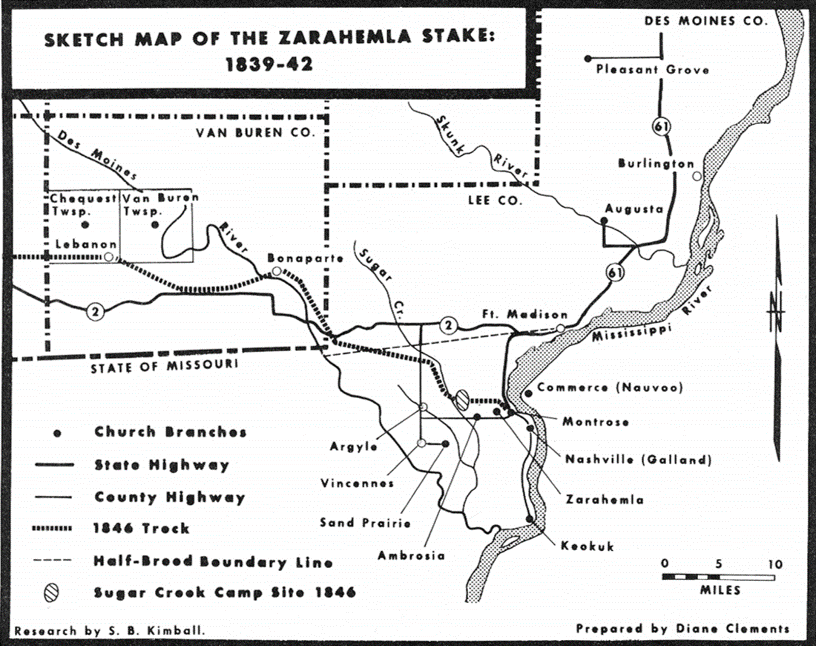 “To date, interest in the Illinois period of Church history has focused largely on events within the corporate limits of the city of Nauvoo, but many Saints lived elsewhere in that general area. Eight short-lived stakes were organized in other Illinois communities: in Ramus (now Webster), Hancock County; at Lima, Quincy, Mount Hope (now Columbus), and Freedom (near Payson), Adams County; in Geneva, Morgan County; in Springfield, Sangamon County; and in Pleasant Vale (now New Canton), Pike County. There was also the longer-lasting Iowa or Zarahemla Stake immediately across the Mississippi River from Nauvoo in Lee County, Iowa.
“To date, interest in the Illinois period of Church history has focused largely on events within the corporate limits of the city of Nauvoo, but many Saints lived elsewhere in that general area. Eight short-lived stakes were organized in other Illinois communities: in Ramus (now Webster), Hancock County; at Lima, Quincy, Mount Hope (now Columbus), and Freedom (near Payson), Adams County; in Geneva, Morgan County; in Springfield, Sangamon County; and in Pleasant Vale (now New Canton), Pike County. There was also the longer-lasting Iowa or Zarahemla Stake immediately across the Mississippi River from Nauvoo in Lee County, Iowa.
In many ways the eastern part of Lee County may be considered as part of Greater Nauvoo. Land was purchased in both areas at the same time from the same person. Stakes were established in both places. Apostles and other Church leaders lived on both sides of the river for a season. Joseph Smith preached and visited in Lee County and on at least two occasions sought refuge there and on Dundee Island which lay close to the Iowa shore. A weekly news paper titled the Nauvoo Ensign and Zarahemla Standard was projected, but never printed. The Mormons helped found Masonic lodges in Montrose and Keokuk. The settlements were connected by ferry and the Church met opposition in both places. The Sugar Creek camp and staging ground for the 1846 trek across Iowa lay seven miles west of the river and the September 1846 (Miracle of the Quails” took place on the Iowa shore.)
Apparently the first Mormons in Lee County were Israel Barlow and about thirty others who fled there from Caldwell County, Missouri, during the fall and winter exodus of 1838- 39. Most Missouri Mormons headed for the ferries at Quincy, Illinois, nd Louisiana, Missouri, but some did not. In Lee County, Barlow was made welcome at Montrose. He was attracted to that community because of the abandoned Fort Des Moines which he figured could house forty or fifty refugee families.1 Upon inquiry he found that the fort and most of the available land near Montrose was claimed by Isaac Galland, an eastern land speculator who had it up for sale. Galland had originally settled in Nashville, Lee County, in 1829, but was then living across the river at Commerce, Illinois, in the James White stone residence…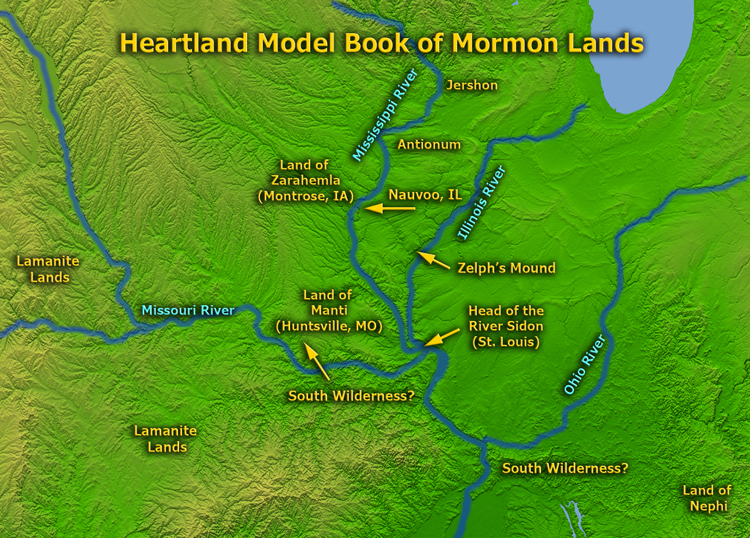
Of these several Iowa communities, Montrose figures most prominently in LDS history. Mormon settlement there apparently commenced in May 1839 (even before any formal land purchases) at which time Brigham Young (not being able to find suitable housing in Commerce) moved his family from Quincy into one of the barracks rooms of deserted Fort Des Moines. He was soon joined by the families of John Taylor, Wilford Woodruff, Orson Pratt, John Smith, Elijah Fordham, Joseph B. Noble, and others. This sudden influx of Mormon squatters alarmed some of the old settlers (some of whom were squatters themselves) who became antagonistic. Joseph B. Noble, for example, was ordered off a garden plot cultivated and Kilbourne, who had laid out the town in 1837, became so hostile that he publicly insulted Joseph Smith and later conspired in an attempt to kidnap the Prophet.
The old fort was the location of Joseph’s well-known healing of Brigham Young and Elijah Fordham in July 1839. He walked into the cabin where I was lying sick [Brigham later recorded] and commanded me, in the name of Jesus Christ, to arise and be made whole. I arose and was healed, and followed him and the brethren of the Twelve into the house of Elijah Fordham, who was supposed to be dying, by his family and friends. Joseph stepped to his bedside, took him by the hand and commanded him, in the name of Jesus Christ, to arise and be made whole. His voice was as the voice of God. Brother Fordham instantly leaped from his bed, called for his clothing and followed us in to the street.
By October of that same year there were so many Mormons in Lee County that a stake-one of the eleven pre-Utah stakes-was organized there. John Smith, an uncle of the Prophet and former president of the Adam-Ondi-Ahman Stake, was sustained as president. He called Reynolds Cahoon and Lyman Wight, who had served with him in Missouri, as counselors. Erastus Snow, Elijah Fordham, William Clayton, and Asahel Smith, among others, served on the high council, and Alanson Ripley was called as the bishop. (Membership was so small it was believed one bishop would suffice.) This stake soon became and remained, next to Nauvoo the second most important stake and community of Mormons in the United States. This was especially true after 24 May 1841 when Joseph Smith officially discontinued all other stakes except those in Nauvoo and in Lee County…
In March 1841 Joseph Smith received a revelation (Doctrine and Covenants 125) regarding the Iowa Stake. In it the Lord in structed the (‘Saints in the Territory of Iowa” to build up a city unto my name upon the land opposite the city of Nauvoo, and let the name of Zarahemla be named upon it. And let all those who come from the east, and the west, and the north, and the south, that have desires to dwell therein , came up their inheritance in the same, as well as in the city of Nashville. . . .” ( D &C 125:3- 4) Nauvoo West: The Mormons of the Iowa Shore by Stanley B. Kimball
The Trail of Hope: Exodus from Nauvoo
Art and early Church members’ words can help us imagine what the pioneers felt when they were forced from Nauvoo.

At the final dedicatory service for the Nauvoo Illinois Temple on June 30, 2002, President Gordon B. Hinckley (1910–2008) asked those in attendance to walk down Parley Street to the waterfront on the Mississippi River. Though it was a hot, humid day, President Hinckley asked everyone to imagine that it was a bitter cold day in February 1846. That summer evening, more than one thousand Latter-day Saints walked down Parley Street, now referred to as the Trail of Hope.
Today those who visit Nauvoo can also walk the Trail of Hope and imagine that it is a bitter cold day in February and how the pioneer Saints felt when they looked back at the temple for the last time. Plaques line the Trail of Hope with quotations from pioneers who left Nauvoo on that February day or during the following months.1 They help us imagine what it was like.
Mary Field Garner, 10 years old when the mob drove her family to leave Nauvoo in September 1846, tells how her family hurried to pack food, cooking utensils, clothing, and bedding. With the bread dough risen and ready to bake, Mary’s mother simply took it with them to bake after they crossed the river.
During one of the earlier crossings of the river, a boat sank, and Hosea Stout recounts how several Saints were tossed in the cold and unrelenting waves.
Describing some of the pioneers’ first camps, Gilbert Belnap states that some had only a sheet drawn over a few poles to make a tent. He remembers hearing the crying of children and the groaning of those sick with fever.
Zina H. Jacobs Young gave birth to a baby boy after traveling about 80 miles west. She says she did not mind the hardship because her life had been preserved and her baby was so beautiful.
Some Saints were unable to go west. Martha Ann Smith was five when she said good-bye to her dear but feeble grandmother Lucy Mack Smith, who shed bitter tears knowing it was the last time she would see her son Hyrum’s family.
“Those of us who can remember when we were compelled to abandon Nauvoo, when the winter was so inclement, know how dark and gloomy the circumstances of the Saints were, with the mob surrounding our outer settlements and threatening to destroy us. … The word was to cross the Mississippi and to launch out into an unknown wilderness—to go where, no one knew. Who knew anything of the terrors of the journey thither, or of the dangers that might have to be met and contended with? … [We moved] out with faith that was undisturbed by [these] unknown terrors. It was by faith that this was accomplished.” George Q. Cannon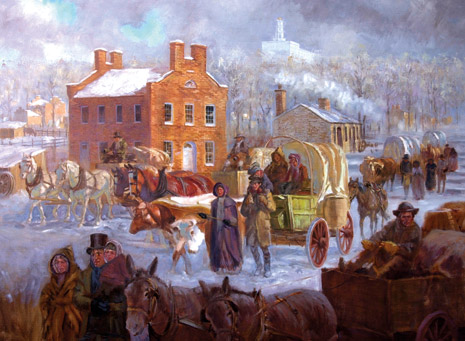
Down Parley Street, by Glen Hopkinson, portrait of George Q. Cannon courtesy of Church History Museum
“My last act in that precious spot was to tidy the rooms, sweep up the floor, and set the broom in its accustomed place behind the door. Then with emotions in my heart … I gently closed the door and faced an unknown future, faced it with faith in God.” Bathsheba W. Smith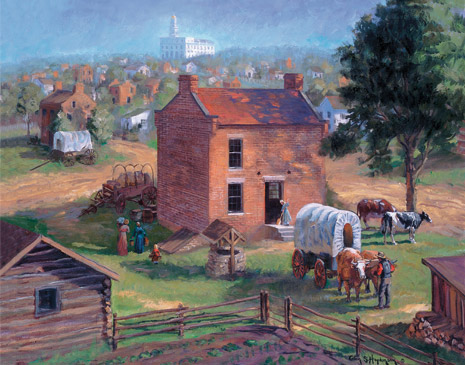
I Swept the Floor and Gently Closed the Door, by Glen Hopkinson, portrait of Bathsheba W. Smith by Lee Greene Richards
“Here we all halted and took a farewell view of our delightful city. … We also beheld the magnificent Temple rearing its lofty tower toward the heavens. … My heart did swell within me.” Newel Knight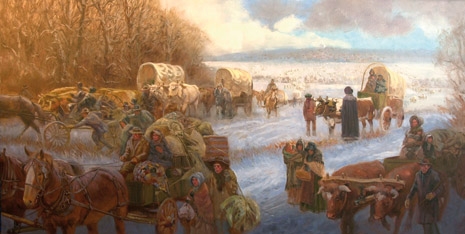
“How well I remember what a hard time [father] had breaking in the animals to draw the wagon. There were six cows and two oxen. The oxen were well broken and quite sedate. But the cows were wild and unruly. … Many nights when we were in bed asleep [my mother] would go out into the orchard … and there pour out her soul in prayer, asking the Lord to open the way for us to go with the Saints.” Margaret Judd Clawson
“With this advanced camp of the great exodus there had come a brass band, led by Captain Pitt. After encampment was made and the toils of the day were over, the snow would be scraped away, a huge fire or several of them kindled within the wagoned enclosure, and there to the inspiring music of Pitt’s band, song and dance often beguiled the exiles into forgetfulness of their trials and discomforts.” B. H. Roberts
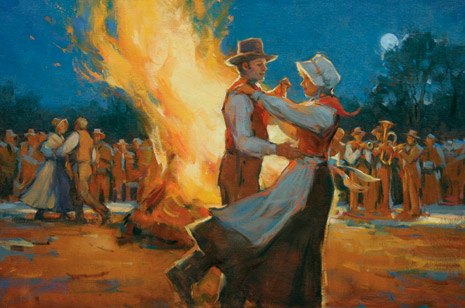
Illustration by J. Ken Spencer
https://www.churchofjesuschrist.org/study/ensign/2013/07/the-trail-of-hope-exodus-from-nauvoo?lang=eng
Annotated Book of Mormon Page 528-529

We first learn of the name Zarahemla in Omni 1:12: “Behold, I am Amaleki, the son of Abinadom. Behold, I will speak unto you somewhat concerning Mosiah, who was made king over the land of Zarahemla.” Zarahemla was the leader of his group who descended from Mulek, son of Zedekiah, king of Judah (Omni 1: 15, 18). Within the land, which was named after him, was the city of Zarahemla, eventually to become the Nephite capitol. The Book of Mormon has 164 references to either the land of, or the city of Zarahemla for many hundreds of years before and after the coming of Christ to the Promised Land.
It is important then to understand the significance of the revelation given to the prophet Joseph Smith in March 1841. The revelation is in response to Joseph’s concern for the members of the church living in the territory of Iowa:
“What is the will of the Lord concerning the saints in the Territory of Iowa?
‘Verily, thus saith the Lord, I say unto you, if those who call themselves by My name and are essaying to be My saints, if they will do My will and keep My commandments concerning them, let them gather themselves together unto the places which I shall appoint unto them by My servant Joseph, and build up cities unto My name, that they may be prepared for that which is in store for a time to come. Let them build up a city unto My name upon the land opposite the city of Nauvoo, and let the name of Zarahemla be named upon it. And let all those who come from the east, and the west, and the north, and the south, that have desires to dwell therein, take up their inheritance in the same, as well as in the city of Nashville, or in the city of Nauvoo, and in all the stakes which I have appointed, saith the Lord’” (Doctrine and Covenants 125:1-4).
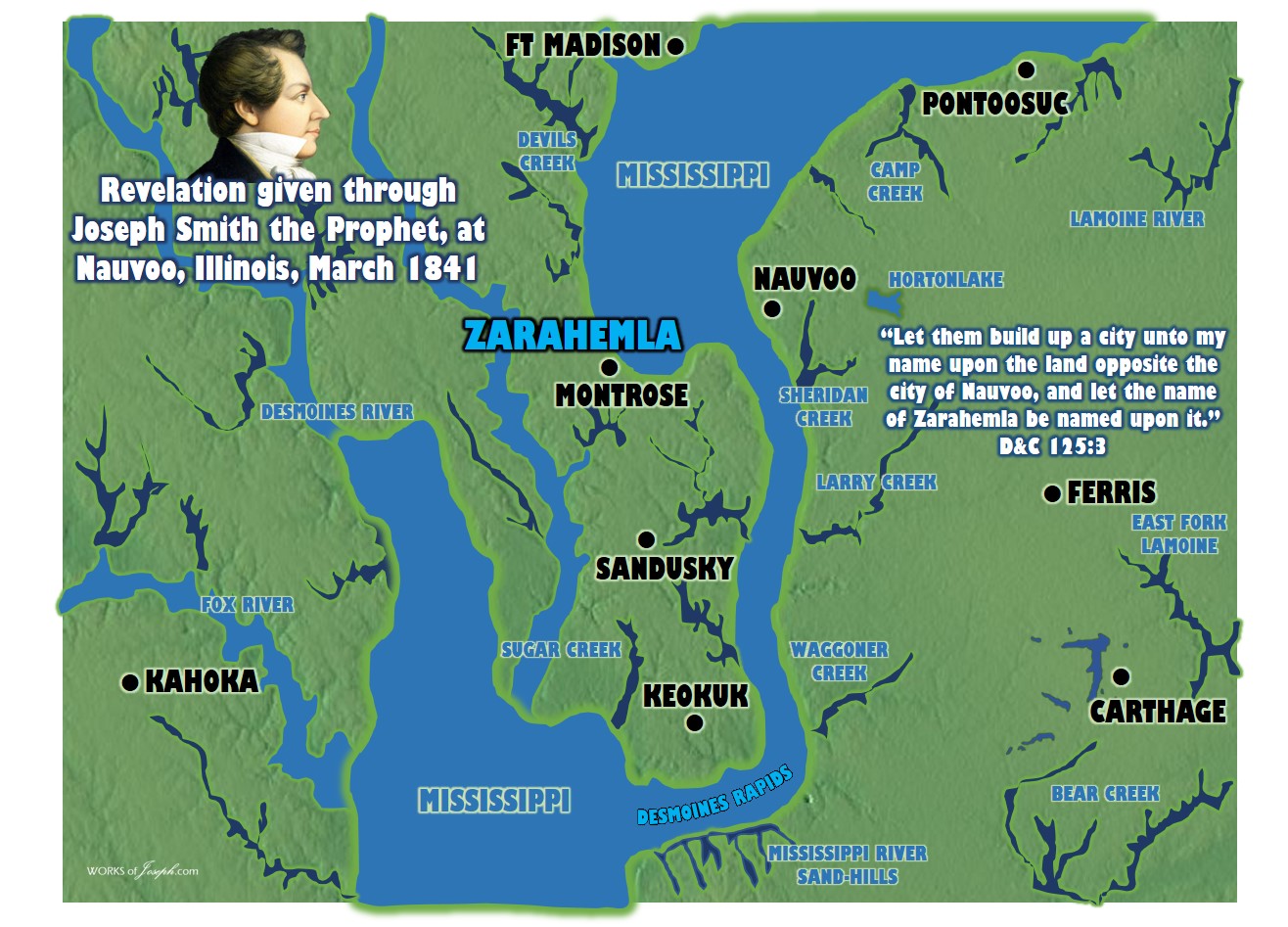
Recent research has been conducted to determine if this revelation was the first indication that a Book of Mormon city would be associated with a location in North America. Previously Joseph had received revelations naming the New Jerusalem (D&C 45:64-67) in March 1831, and Adam-ondi-Ahman (D&C 116) in May 1838, with both being in the state of Missouri.
During the Nauvoo period of Church history between 1839 and 1844, Joseph Smith had many dealings with the Lamanites of the area. He was well acquainted with the Indian people of the Eastern United States during early Church History development. He had written in the early 1830s that “the Book of Mormon is a record of the forefathers of our western tribes of Indians.” (Teachings of the Prophet Joseph Smith [2002], 13). Even in the 1830s he had authorized special missions to the Native Indian people of the area (Sections 30 and 32 of the Doctrine and Covenants). Joseph escaped the Liberty jail in Missouri on April 16, 1839 and crossed the Mississippi River into Illinois by April 22, 1839. Within days the Prophet again crossed the river and “went to Ioway [sic] made purchases.” (Joseph Smith Papers, Journals, V. 1, 336.)
There are three different historic accounts from the 1839-1841 era that provide insights to when the name Zarahemla was first used.
First: Approximately eight weeks after his escape from jail, we read from The Joseph Smith Papers an entry as follows:
2 July 1839-Tuesday
“Tuesday, Spent this day on the Iowa side of the [Mississippi] river. Forenoon went in company with Elders Rigdon and Smith, Bishops Whitney and Knights and other to visit a purchase lately made by bro Knights as a location for a town, Advised that a town be built there…” (Ibid., 344).
Note however, the following entry from Joseph Smith, History of the Church of Jesus Christ of Latter-day Saints V. 3, [1948], 382:
“Spent the forenoon of this day on the Iowa side of the river. Went in company with Elders Rigdon, Smith, and Bishops Whitney and Knight, and others, to visit a purchase lately made by Bishop Knight as a location for a town, and advised that a town be built there, and called Zarahemla.”
Conclusion: The phrase “and called Zarahemla” was added to the narrative post 1841.

Second: In the Manuscript History account of another early Church leader, Brigham Young, we find a reference as follows: “July 2 (1839). Brothers Joseph, Hyrum, and others came over the river to Montrose, and went out on the prairie and looked out the sight for a city for the Saints, which was called Zarahemla.”
Significantly, however, the actual Brigham Young Journal in the possession of the Church
History Library, and in the handwriting of Brigham Young, including brief notes in 1839 for only September and October, does not have a reference to Zarahemla. He only mentions visits to Montrose and Quincy during this period.
Conclusion: The phrase “which was called Zarahemla” was added to the narrative post 1841. This journal is in the Church History Department and several individuals have viewed or had view of this journal and have read the words penned by Brother Brigham Young.
Third: There are two different Elias Smith Journals of 1839-1841 (Smith, Elias, Journals 1839- 1841) in the possession of the Church History Library. The first is a small 4 x 5 inch sheet of paper folded in half and forming a small booklet. Elias makes brief references in 1839 to October 12 and 19. He then makes entries for 1840. These include “April 6 conference in Nauvoo”, “July 12 conference at Ambrosia. chosen Bishop of the branch of the Church in Iowa”, and “July 18 ordained to that office.” Brief August entries are the 9th, 16th, 23rd, and 30th. He then makes reference to “Sept 6th meeting in Nashville”, “13th fyo” (word not decipherable), “14 Joseph Smith Senior died and buried 15th”, and “16th, Des Moines steamer came up from Quincy”.
The entries of this small record then skip forward to 1841 with three brief citations. “7 August Conference at Zarahemla. Don Carlos Smith died.” “8th Buried.” “16 Conference at Nauvoo.” There are no further references for 1841 and the record ends. It is important to know that the death date of Don Carlos Smith (cited above) occurred in August 1841. The entries on the same page as the 1840 events were actually added to that page as events occurring in August 1841.
The other Elias Smith journal consists of two 8 x 12 inch pieces of paper for the year 1841. At the end of the references in February 1841, and at the bottom of the same page, he makes entries for March 1841, giving notations for eight days. Among these eight daily references are: “3rd Zarahemla surveyed about this time. Rained for the first time this spring or for two or three months.” “16th First locations made in Zarahemla by the citizens of Ambrosia.” These entries certify the revelation did indeed occur in 1841. It is interesting that Brother Smith says “about this time” because this allows for several days in early March in which the revelation could have occurred.
Conclusion: The use of the name Zarahemla is accurately associated with the March 1841 revelation in Section 125 of the Doctrine and Covenants from the Lord to the Prophet Joseph Smith. This is an important piece of information provided by these early journal historians. Therefore, we have learned that previous references to Zarahemla (as cited above), which were pre-March 1841, were inserted by scribes and writers who were not the actual writers—Joseph Smith, Brigham Young, and Elias Smith—after the true date of the revelation.
In History, 1838–1856, volume C-1 [2 November 1838–31 July 1842], p. 1173, The Joseph Smith Papers, on Saturday, March 20, 1841 Joseph records: “About this time I received a revelation in the City of Nauvoo.. ‘…Let them build up a City unto my name upon the Land opposite to the City of Nauvoo, and let the name of Zarahemla be named upon it.’”
Comment: The Lord has named three cities in the revelations of the Doctrine and Covenants: The cities of the New Jerusalem, Adam-ondi-Ahman, and Zarahemla. He has revealed the ancient location of Adam-ondi-Ahman and the future location of the New Jerusalem in America. In choosing to name Zarahemla, a city across the river from Nauvoo, is the Lord suggesting the location of the Book of Mormon city? This consideration is due to Zarahemla being the focal point of travel and commerce, the establishment of the church, missionary work, Nephite–Lamanite interaction, temple emphasis, and prophets of former generations. Placing a “pin in the map” on this location throughout the book aids in our understanding the significance of this sacred place.” Annotated Book of Mormon by David Hocking and Rod Meldrum 2018 Page 528-529
Heartland Research Group
December 8, 2020. First Radiocarbon Date Connects to Zarahemla – West Bank of Sidon River (Mississippi River) Clamshell Found in Field on West Bank of Sidon River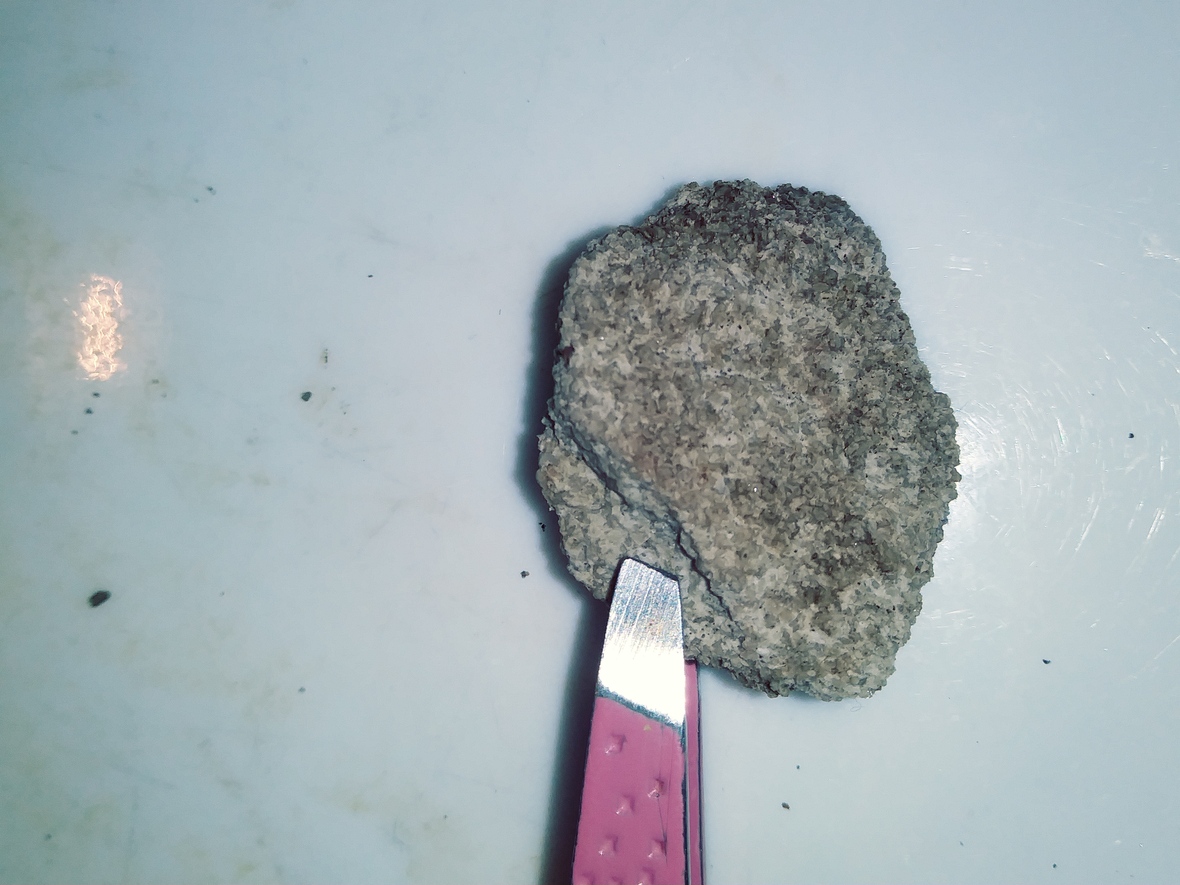 Clamshell from Fire in Zarahemla at about the Time of Arrival of Mosiah and the People of Nephi. Artifact Connects to Zarahemla’s Timeline : 225 BC +/- 30Today the Vilnius Radiocarbon Laboratory released the first date for connecting a specific object to a specific time in Zarahemla. The place is clear. The time is clear. The radiocarbon date indicates that there was a clambake in an ancient fire at about the time when Mosiah and the people of Nephi arrived in Zarahemla. The clamshell came from a fire pit located by the SENSYS MX V3 scanning and tested for a time just before the arrival of Mosiah and his people to Zarahemla. The radiocarbon date is 225 BC +/- 30 years. The scientific results are clear and unambiguous. The half-life of the carbon-14 isotope is the clock that connected the clamshell from the ancient fires to the City of Zarahemla. Last week radiocarbon from the clamshell accelerated to speeds that were a few percentage points less than the speed of light. At that high speed, the radiocarbon separated by weight from stable carbon atoms. After the separation, the radiocarbon landed on a target where the isotopes were counted one at a time. More Here:
Clamshell from Fire in Zarahemla at about the Time of Arrival of Mosiah and the People of Nephi. Artifact Connects to Zarahemla’s Timeline : 225 BC +/- 30Today the Vilnius Radiocarbon Laboratory released the first date for connecting a specific object to a specific time in Zarahemla. The place is clear. The time is clear. The radiocarbon date indicates that there was a clambake in an ancient fire at about the time when Mosiah and the people of Nephi arrived in Zarahemla. The clamshell came from a fire pit located by the SENSYS MX V3 scanning and tested for a time just before the arrival of Mosiah and his people to Zarahemla. The radiocarbon date is 225 BC +/- 30 years. The scientific results are clear and unambiguous. The half-life of the carbon-14 isotope is the clock that connected the clamshell from the ancient fires to the City of Zarahemla. Last week radiocarbon from the clamshell accelerated to speeds that were a few percentage points less than the speed of light. At that high speed, the radiocarbon separated by weight from stable carbon atoms. After the separation, the radiocarbon landed on a target where the isotopes were counted one at a time. More Here:
November 6, 2021
Just a note from the FIRM Foundation about the work moving forward by the Heartland Group headed by Wayne May, John Lefgren and many other Heartlanders. Below is some information and some videos showing you the beginnings of their current gathering this week near Nauvoo.
Dateline Zarahemla. Digging in the Dirt. August 7th, AD 2021
“Forces Gathering on the West Bank of the Sidon River.
Today more than 50 people are preparing to travel tens of thousands of miles to the site of North America’s largest 4th Century city. The professional experience of these many people totals more than 500 years.
The expedition has a clear focus and purpose. We seek to discover truth from the ground that connects to the most important city that is found in an ancient book of scripture. We are employing the most advanced noninvasive technologies in the world. This time the Russians are coming to help us see what until now has remained unseen. The Russians have equipment that will use electrical charges to identify anomalies in the ground that are associated with the ancient activities of the citizens of Zarahemla. More here:
Nov. 6th 2021, a historic flyover near Nauvoo, Illinois of 34,000 acres has been completed, obtaining Lidar Data to continue searching for more evidence about the Montrose, IA, or the Zarahemla area. In the Nauvoo Heartland Research is finding ancient fire pits and artifacts, doing core hole drilling, magnetometry, lidar, archaeological digging, drone exploring, and many other new world scientific studies from experts all over the world. You will be fascinated with their work below. They would love to have guests, visitors, speakers, and other experts that may want to help. Email John or Wayne at the information on their website.
Heartland Research is also continuing study of the Michigan plates that Wayne May has been researching over 30 years, and continuing to research information about the Spotted Bee Balm plant growing in the Montrose, Iowa area. More here:
April 29th Expo
Join us for much more. Including the recent purchase of the original replica 600 BC ship sailed by Navy Captain Philip Beale in 2009 by a route from Oman to Florida that proves there was a way for Lehi to travel by ship to the United States of America. And Captain Beale also completed a voyage from Tunisia to Florida in the same replica Ship in 2020 which proved that Mulek could have sailed to the United States as well. Tickets
It is correct when I say, Heartland Research Group OWNS that replica ship, “The Phoenicia” and half of it is sitting in a potential museum site in Montrose, Iowa as of a few weeks ago. Take a look at more information here.
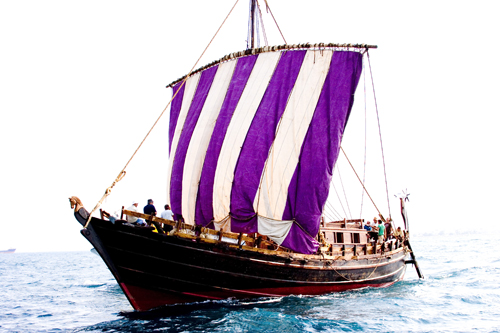 April Expo Phoenicia Ship Updates
April Expo Phoenicia Ship Updates
Join us to help rediscover the Land of Zarahemla in the Heartland of the United States. Come to our April 7-9, 2022 Expo and meet the Heartland Group, Captain Beale from England and see many speakers like Rod Meldrum, David Doane, Wayne May Mike and Betty LaFontaine, and Boyd Tuttle who will all speak about this newly purchased ship.

